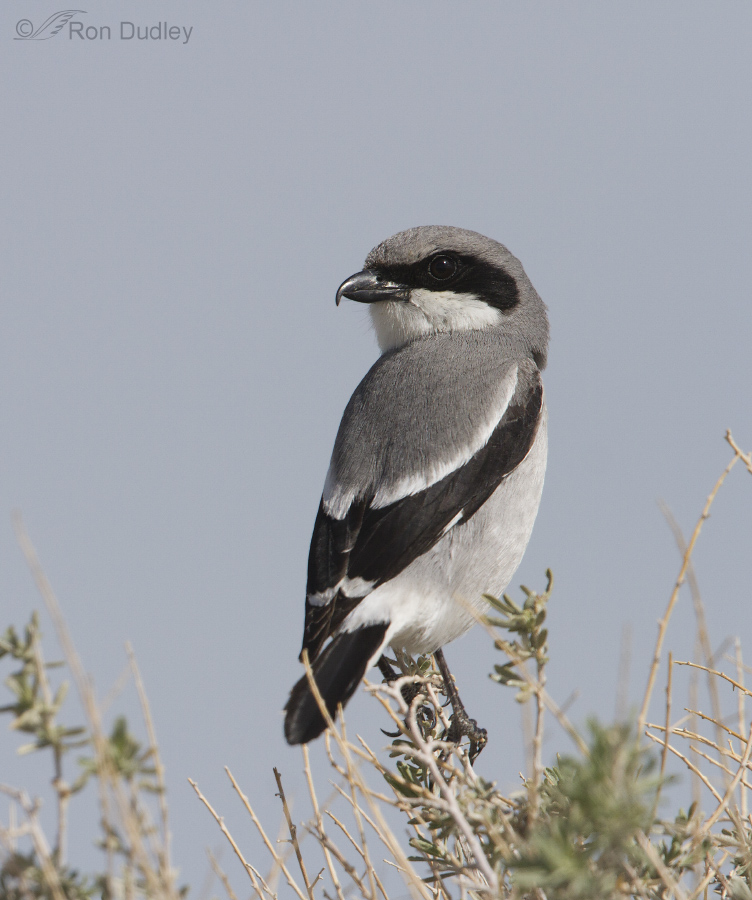Loggerhead Shrikes have several distinguishing characteristics including a mean-looking hooked beak and a black facial mask but it’s their very large head that gave them their common name.
In the 16th century a “logger” was a large block of wood for hobbling a horse. The term loggerhead came to mean “blockhead” or something with a disproportionately large head. Several disparate species were named for that characteristic including the Loggerhead Sea Turtle and Loggerhead Sponges (huge sponges whose barrel shape resembles a head).
I’ve long been aware of the unusually large head of the Loggerhead Shrike but yesterday morning one bird in particular drove that fact home for me.
1/3200, f/7.1, ISO 400, Canon 7D, Canon EF500mm f/4L IS II USM +1.4 tc, not baited, set up or called in
As soon as I had this bird in my viewfinder I was struck by the size of its head. In fact I remember saying out loud “This bird’s head is HUGE!”. Just as human head sizes vary (think of the variety of hat sizes), so must those of birds and other animals. To my eye this one appears massive compared to the average relative head size of most other birds and it also seems noticeably larger than that of most other Loggerhead Shrikes .
Perhaps it’s a figment of light or angle or my imagination. But I don’t think so…
Ron



Just beautiful Ron!
Charlotte
It needs a big head, and muscular neck, to carry that beak. And find myself wondering what Kipling would have written about ‘how the Loggerhead Strike got its name….’
Elephant’s Child, I wondered if the reason for the “big head and muscular neck” might be related to the extra muscles required to kill and tear up larger prey like birds and small mammals. And yeah, who knows what Kipling might have said…
Interesting information…and photo. My first reaction when I opened to this shot was, “I wonder what angle he took this from…the head looks so big, out of proportion to the body!” I didn’t know the background of the term “loggerhead”. This bird’s head looks at least a third or more bigger than you’d expect….
Thanks, Patty. Glad you agree about the head.
It is not your imagination Ron. I went to see my Bird guide-book and among several factors that describe this species they say “big head”.
We also have it here in Portugal and it’s named “Picanço-Real”
Nice photo, so detailed that we can see the pupil in the iris of the eye.
Thank you for the “loggerhead” explanation.
Jorge, I looked up “Picanco-Real” on wiki and it included a range map of the species “over there”. Interesting how its range completely circles both the Sahara Desert and the Arabian peninsula. Thank you.
I believe raptor implies catching prey WITH the feet… I hope Louise Shimmel (Cascades Raptor Center) or another raptor expert will chime in, but that’s how I’ve heard the explanation of why a shrike is not a raptor.
That makes perfect sense to me, Barbara.
Hi Ron, I teach a little course on raptors and my students frequently ask about shrikes, the “raptor wannabe”. I also happen to live in a town in Oregon that is famous for its Shakespeare festival. You probably know that birds are the animals most frequently mentioned in Shakespeare’s works. Therefore, I have been putting together little snippets that connect raptors and Shakespeare. Which is a long way of saying this quote from “Love’s Labours Lost” provides an example of loggerhead (meaning blockhead) as pejorative – “Ah you whoreson logger-head, you were borne to doe me shame.”. As Juliet (in Romeo & Juliet) once said, “What’s in a name?”. Hope this isn’t too far off track…
Cheers,
Dick
Not “too far off track” at all, Dick. Perfect! I love this kind of stuff…
Thanks, as always, for nice shot and interesting info.
Thank you, Patricia.
Nice photo Ron. I have wondered if a shrike is considered a raptor or not, and why or why not? They kill other birds, have a hooked beak, not sure about their talons though. What do you think ? Thanks.
No, I don’t believe they’re considered raptors, Ed though the “bird of prey” definition of raptor is a little murky. After all, any bird that eats insects could also be considered a bird of prey. Shrikes are considered to be passerines rather than raptors, though their habits of hunting larger prey (top-level predator) and their hooked bills with a “falcon (tomial) tooth” do mimic the raptors. Shrikes are often called “raptor wannabe’s”.
Thanks Ron. Also thanks for the education on what a “loggerhead” means, I did not realize that. The shrikes are neat birds, I find them hard to photograph since they are often very skittish. Your photo does an excellent job of capturing their facial mask and details.